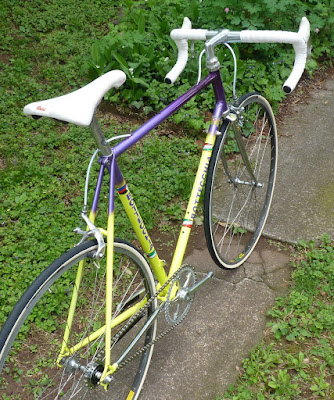It’s hard to believe it has been six months
since I started this Gios-Torino Super Record project, and in a way, it feels
like the process has completely coincided with the start and end of the winter!
Well, spring has definitely arrived in the last couple weeks, with a few of
those days feeling more like we skipped directly into summer. I’m not really
complaining, except that maybe it was a little rough riding in the 90-degree
temps without having any time for my body to adjust to the conditions.
A big part of the delay in polishing off the
Gios was out of my control, as acquiring a few of the late ‘70s parts was
incredibly difficult, especially if I didn’t want to pay a fortune for them.
The most challenging of parts to find was an appropriate bottom bracket. The
search was made doubly difficult because at the same time I was attempting to
find a similar part to finish my friend Brendan’s Tommasini.
Just when I finally found a bottom bracket
for the Gios, I realized I forgot to find downtube shift levers. If you recall,
I had bought the bulk of the Super Record group with the
Peugeot,
and it had slipped my mind that the PX 10/E had Simplex levers, and I had never
purchased a replacement for those parts.
A couple weeks later, I had a pair of Super
Record levers to install, and I was able to roll out the Italian classic for
some photos:
I have finally purchased everything for
Brendan’s two projects, and I have been piecing the two bikes together gradually
as I await the last couple of parts to arrive in the mail. It’s been a bit
awkward in my shop lately, as I’ve been constantly shifting bicycle positions
in my rafters as I’ve been working on them, and I fully realized that at this
moment I have too many builds going on all at once!
The current process hasn’t run quite as
smoothly as
Cinquebicicambio , but it is inching
closer to completion anyway. I started with the Vitus 979 from Brendan, which had
a base of Shimano 600 parts, and I had intended to complete that group with the
600 crankset from the “donor” Saronni. My new friend Arol intercepted that
build with a Mavic parts plan, which is not a problem, except for a further
accumulation of parts to sort through and decide which are suitable for future
use and which will be sold.
I actually found a very inexpensive red
Vitus 979 frameset recently on eBay, and I am simply going to put the Shimano
parts right onto that, keeping in the general line of my original build plan. A
quick search on eBay netted a headset and pair of wheels to complete the 600
group, as I had originally hoped the Shimano mix on the Saronni might help fill
in the gaps, but found it had a 105 headset and a disappointingly inferior
wheelset built from Sun rims and Origin 8 hubs.
I few weeks ago I received a message from a
gentleman named Lenny, who had seen some of my craigslist-ings and was very
generous with his comments about my work. Through many incredible stories he
shared, I learned Lenny is in his 70s, has led a very interesting life and is a
bit of a globe-trotter. He has an incredible collection of bicycles, including
a DeRosa that he wants to update with more modern components. I have a
Campagnolo Centaur group that I received on-the-cheap, including a nice set of the
company’s Nucleon wheels, and this sparked his interest. Through email exchanges,
we came up with the idea of a work/parts swap for the Super Record components that
are currently on the DeRosa.
Although he lives outside of Boston, Lenny
wasn’t too keen on shipping the bike back and forth. He has preliminary plans
of a visit to the Philadelphia area, with the hope that he can drop of the
DeRosa in Royersford, and I can take care of the work while he is off
exploring.
On a recent sunny day, I actually got to
devote some time to yet another project, my own Pinarello Asolo, which had been
purchased already stripped of its paint, but the frame needed some cleanup/prep
work before I add color of my own. My second attempt at the pseudo-
cromovelato giallo (yellow) will involve
a chrome-like finish I used many years ago on the lugs of a
Motobécane
re-paint job. A base of glossy black will be applied, followed by a coat of Dupli-Color
chrome and then the Metalcast yellow tint on top.
I had been going back and forth in my mind
about the Pinarello decals that I want to put on the frame. Although I like the
black decals I had applied to the Coppi, I think I am going to go a different
route this time around. I’ve seen yellow cromovelato Battaglin and Razesa
bikes, as well as the copper Wilier Triestina, all with simple white logos, and
I think it looks really classy.
 |
| The look I'm hoping to achieve with the Pinarello |
Believe it or not, I have a couple other
projects in-the-works, but I have so much on my plate right now, I’m going to
hold off on getting into discussing those for a little while.








































